 TOURISM TOURISM |
 Bucharest Bucharest |
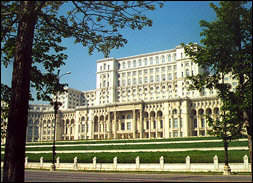
Bucharest is located in the southern part of the country, in the Romanian Plain. It was founded by the princes of Wallachia in the XIV century and it was recorded for the first time in 1459 as the residence of Prince Vlad Tepes. It became the capital of Romania in 1862 when Wallachia and Moldova reunited. The city reached its peak in the XIX century, when French architects and Romanian ones educated in France transformed the city into a little Paris. During the Communist era, whole neighborhoods were flattened out in order to erect large avenues without any personality. However, large parts of the city still remain intact. Today the visitor can get lost in the winding streets where XIX century houses look dormant. Streets full of antique shops or just plain art nouveau palaces speak of the glorious past of this city. A visit to the Athenaeum, the Peasant museum (Muzeul Satului) an open-air museum full of peasant houses are a must. A stroll around the city visiting its many lost orthodox churches can turn out to be a gratifying experience. The Cathedral of the Patricarch, or the Russian church are quite impressive. The little precious monastery of Stavropoleos is a must. In fact, the small street where it is located is full of beautiful palaces and perspectives such as the CEC Bank or the Caru-cu-Bere Restaurant.
Ceausescu's legacy was the Palace of the people, a massive building considered the 2nd largest one in the world in terms of volume. Facing the gigantic Unirii Bulevard and Piata Uniri, the building looms like a pyramid or a white fortress. It can be seen from almost anywhere in town.
 Sinaia and Peles Castle Sinaia and Peles Castle |
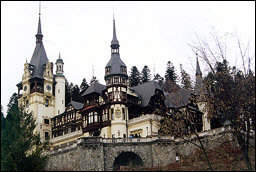
Sinaia although located within Wallachia, due to its location among the Carpathian Range, has much more in common with Transylvania. This city, situated in the middle of an incredible countryside, owes its name to the stones brought from Mt.Sinai to build its monastery. The beauty of this town lays in the elegant villas and hotels constructed in the XIX century. But the true reason for the popularity of this town is Peles Castle, residence to the first Romanian Monarch.
Peles castle, a Bavarian castle in the middle of the Carpathian mountais, was built by King Carol I, a king belonging to the Hohenzollern German monarchy imported by Romania. The castle is full of pinnacles, turrets, and tramp-l'oeil. Inside it is a modern castle boasting all the conforts the XIX century had brought about: hot water, vacuum cleaner, electricity and even a movie theatre. The use of precious woods abound, and it holds an interesting collection of furniture, paintings and tapestries as well as Murano glass chandeliers. It is probably the monument most visited in Romania, and it is well worth the visit.
 Transylvania Transylvania |
Located in the center of the country, protected by the Carpathian range, Transylvania has some of the most beautiful cities in Romania: Brasov, Sibiu, Cluj-Napoca, Tirgu Mures and Sighisoara.
Two hours from Bucharestis located Brasov,a large industrial city with an interesting past. It was originally constructed to defend the mountain pass from the attacks of the Ottomans. The city lies among the massive Carpathian mountains conceding its baroque and medieval houses an excellent dramatic backdrop. Its old town can be walked through since its main street (Str. Republicii) is only opened to pedestrians. The Black church (Biserica Neagra) is a typical example of a fortified church.
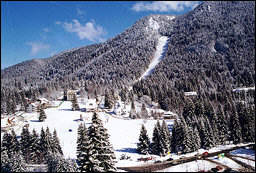
Poiana-Brasov, an elitist and sophisticated ski resort at only 12 Km away from Brasov, Poiana contains some of the best hotels in Romania. In fact when looking for a hotel in Brasov the best choice is to stay in Poiana Brasov, since the hotels in Brasov are overpriced and underdeveloped. Nearby is Bran's Castle, considered by many as Count Dracula's castle. This imposing medieval castle actually belonged to the famous Vlad Tepes. Queen Maria of Romania used to retire there, giving it some warmth despite of the starkness of its white walls.
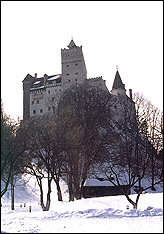 | Sibiu was established in the XII century by Saxons. These people were brought iin by the Hungarian king to repel the Turks. The city flourished with trade, being coveted by its neighbors. For this purpose it was fortified with thick walls containing 40 towers. Today rests of the medieval wall can be found. The center of the city miraculously escaped Ceausescu's destructive hand. Small colorful baroque houses populate the city. Arches give way to inner yards, twisted streets, and steps which in turn lead to two large plazas. The Piata Mara is a baroque plaza with stately buildings that talk about the past splendor of the city. The Brückenthal Museum, the orthodox cathedral and the Orthodox cathedral are worth a look.
Cluj-Napoca was founded to protect the Hungarian King Geza from the attacks of the Ottomans. Also founded in the XII century, today Saxon and Hungarian traces can be found in its streets and churches. Cluj was the former capital of historical Transylvania, and it is nowadays the third academic center of the country. Although it has known better times it is fast improving. This large city contains beautiful Art Nouveau buildings and small baroque houses in the smaller streets. Since Hungarian and Saxon Catholics and Romanian Orthodox lived here, they competed to build the largest church. Today it boasts some of most monumental churches in Romania. This animated city is famous for its cafes and musical life
Downtown (Piata Uniri) holds the most remarkable buildings such as the gothic cathedral of St. Mihael, the Banffy Palace (the art museum), the Pharmacy Museum and the turn of the century Melody and Continental Hotels. At each extreme of Piata Stefan-cel-Mare can be found the large Orthodox Cathedral and the majestic Opera, built at the beginning of the XX century by Viennese architects.
Tirgu Mures is a city with Hungarian heritage. Its wide straight streets contrast with the narrow twisting ones found in Saxon towns. Its center, Piata Trandafirilor, contains the most emblematic buildings: in the North the Orthodox Cathedral built this century seems to respond to the imposing civil Hungarian buildings in the South. the House of culture, the Prefecture and the Roman Catholic Cathedral. The citadel holding a church and a fortress is also worth a visit.
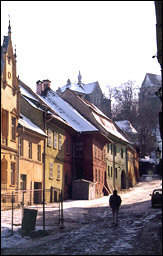
Cuddled by the river Tirnava mare, grows the citadel of Sighisoara. Birth place to Vlad Dracul, it was founded in the Middle Ages, and it was a free city of artisans and traders. A totally Saxon town, its narrow streets guide the steps to the citadel, a true medieval jewel. Perched on a rock grows the fortress that encloses the Clock tower and the German church. The red tiled roofs, winding streets with pastel color houses and the magnificent views of the town and fields are definitely worth the trip. Time has stood still in Sighisorara.
 Moldavia Moldavia |
Iasi was the capital of historical Moldavia since 1565. This highly cultural city holds a number of interesting spots, particularly in Bulevard Stefan cel Mare. Left and right ancient monasteries give way to museums and theaters: the Moldavian Metropolitan Cathedral, the XIX century National Theatre, the incredible Church of the Three Hierarchs, covered with an intricate stone pattern, and the Forty Saints Church. But what is really amazing is the fabulous Palace of Culture, a neo-gothic building of great dimensions that faintly reminds of the Parliament building in Budapest.
The Monasteries of Southern Bucovina in the region of Moldavia are rightly acclaimed as masterpieces. Having been called the Sistine Chapel of Orthodox art UNESCO declared them a World Heritage site. Located in the northernmost corner of Moldavia, these monasteries were erected by King Stefan the Great to commemorate each of his victories against the Ottomans. They were fully painted with biblical images to illustrate the sacred teachings to illiterate peasants and armies while waiting for battle. Some of these monasteries' frescoes are painted in the outer walls, and despite the passage of time and rigors of climate, they have kept the intensity of colors and the strength of their paintings intact. Each monastery is unique, but the green paintings of Sucevita, the red ones of Humor and the blue tones of Voronet cannot but impress the visitor.
 The Black Sea Coast The Black Sea Coast |
The old Roman city of Tomis is today called Constanta. Presently it is the main port at the Black Sea. It still has some remarkable buildings such as the Art Museum, or the remains of two mosques, but Constanta (Constanza) is better known as the destination point for most tourist resorts in the coast: Olimp, Neptun, Jupiter, Aurora, Venus or Saturn. These resorts were developed in the 1970's, and although devoid of any architectural beauty, they remain very popular since the are the only sea resorts. The mud baths in lake Techirghiol are quite an experience, and apparently quite a healthy one. |

